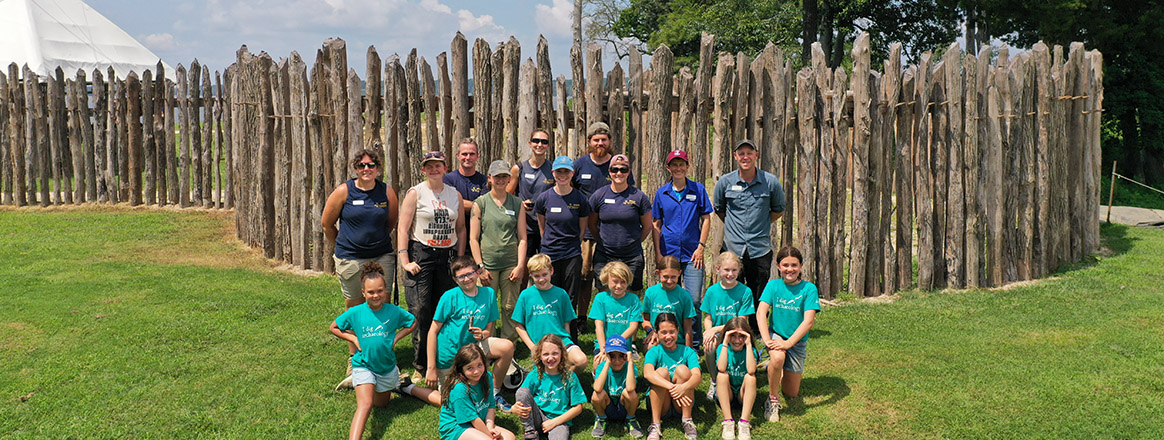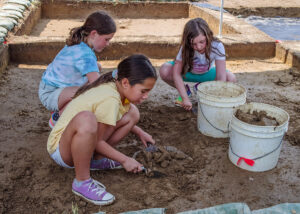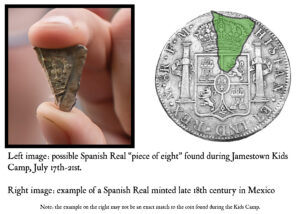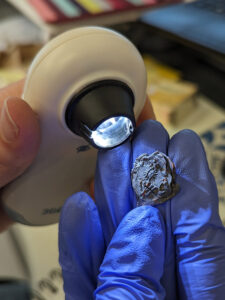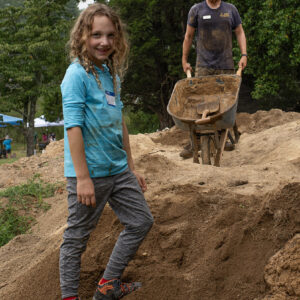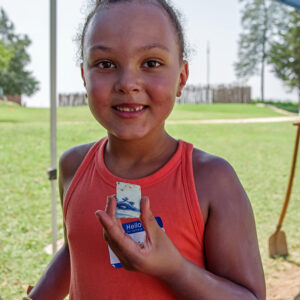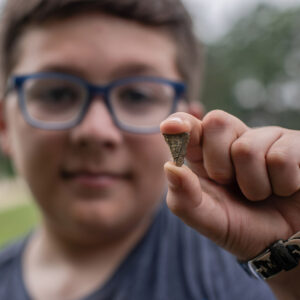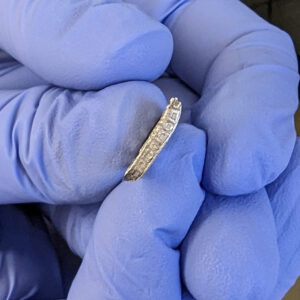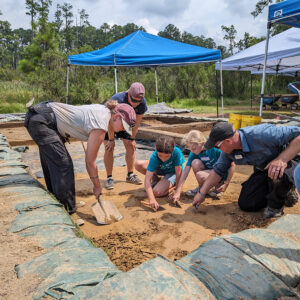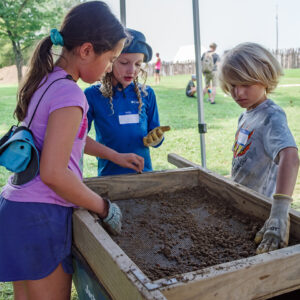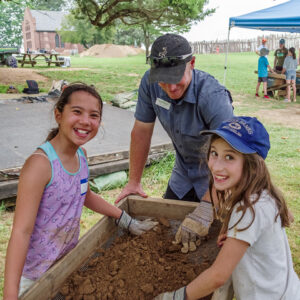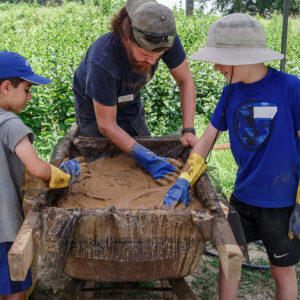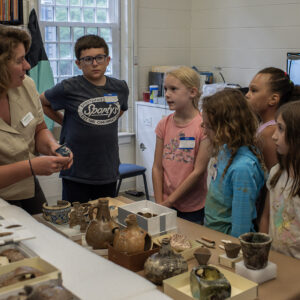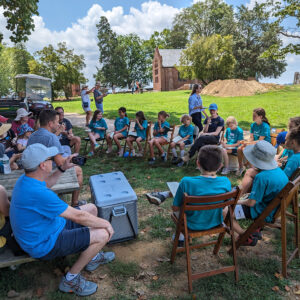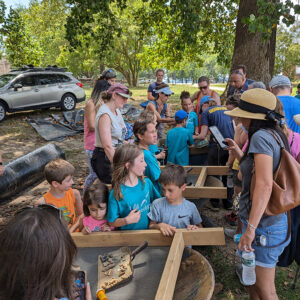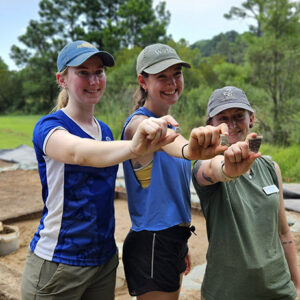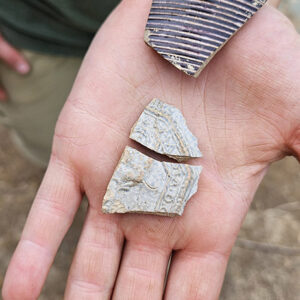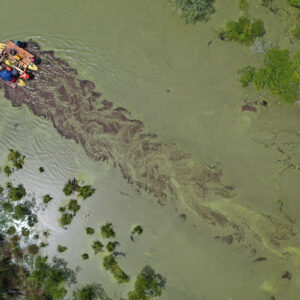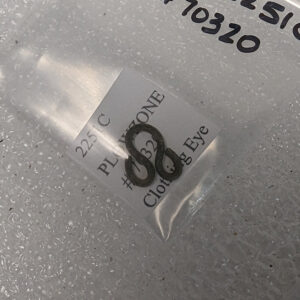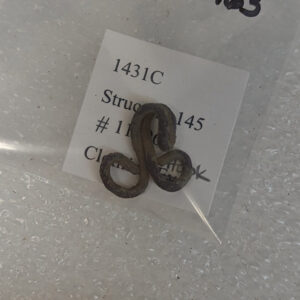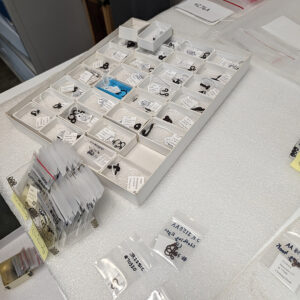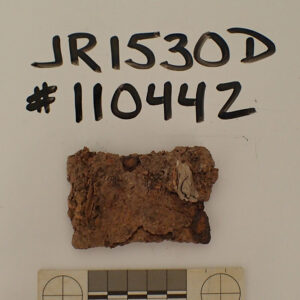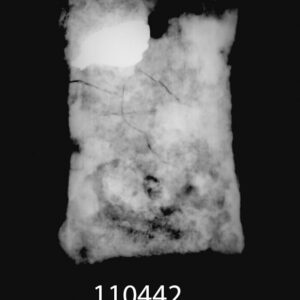Jamestown Rediscovery was happy to have the summer’s first Kids Camp attendees excavating the clay borrow pit this month. The campers were a huge help in excavating the plow zone there and found dozens of artifacts, including the first Spanish eight real in the Jamestown collection, a “piece of eight.” The archaeological staff is digging into one of the subfloor pits found in the field north of the fort by ground-penetrating radar (GPR). This is one of several of these pits found in a east-west line and the team is eager to determine their purpose and time period. The team was excited to welcome the archaeological firm SEARCH to investigate some of the submerged resources on the island. In the Vault, this month’s reference collection work has been focused on conserving and cataloging clothing hooks and eyes, as well as plaster from the 1617 church. Lab analysis on the three burials excavated last fall is complete and DNA samples have been taken for further research. A lead seal found in a pit inside the fort’s western palisade wall has been conserved and features a sun with a human face as well as several letters in ligature form.
The borrow pit — a hole in the ground dug to source clay for a nearby kiln in the latter half of the 17th century — is taking shape thanks to the help of the summer’s first Kids Camp attendees. It is likely that much of this clay-turned-brick was used to build the 1680s Church Tower that still stands several yards to the south. There are a total of five 10×10 squares open at the borrow pit now, as the campers — with instruction and guidance from the archaeological staff — carefully removed the plow zone above the 17th-century layers. The plow zone, the soil disturbed by centuries of farming plows that mixed layers of soil together, also contains artifacts from these mixed contexts. Artifacts can be pulled up from lower layers by plowing and also moved horizontally across the landscape. Because of this, artifacts found in the plow zone can’t be used to definitively date features. But in the case of the borrow pit, where the colonists used it as a trash pit once they stopped making bricks, the trash-turned-artifacts were in abundance for the campers to find while excavating and screening. The campers “moved a lot of dirt” according to Director of Archaeology David Givens, who was impressed with their work ethic and eagerness to learn archaeological techniques.
Senior Staff Archaeologist Sean Romo is leading the dig at the borrow pit and says that the plan there is to remove the plow zone and other later layers in all of the squares. Then, his team will sample the borrow pit and the exploratory trench made by archaeologist J.C. Harrington’s team in 1941. With a portion of Harrington’s trench removed, the team will be able to get a profile of the borrow pit and see and record its stratigraphy before proceeding. Borrow pits are often irregularly shaped at their bases, from multiple iterations of clay removal and filling.
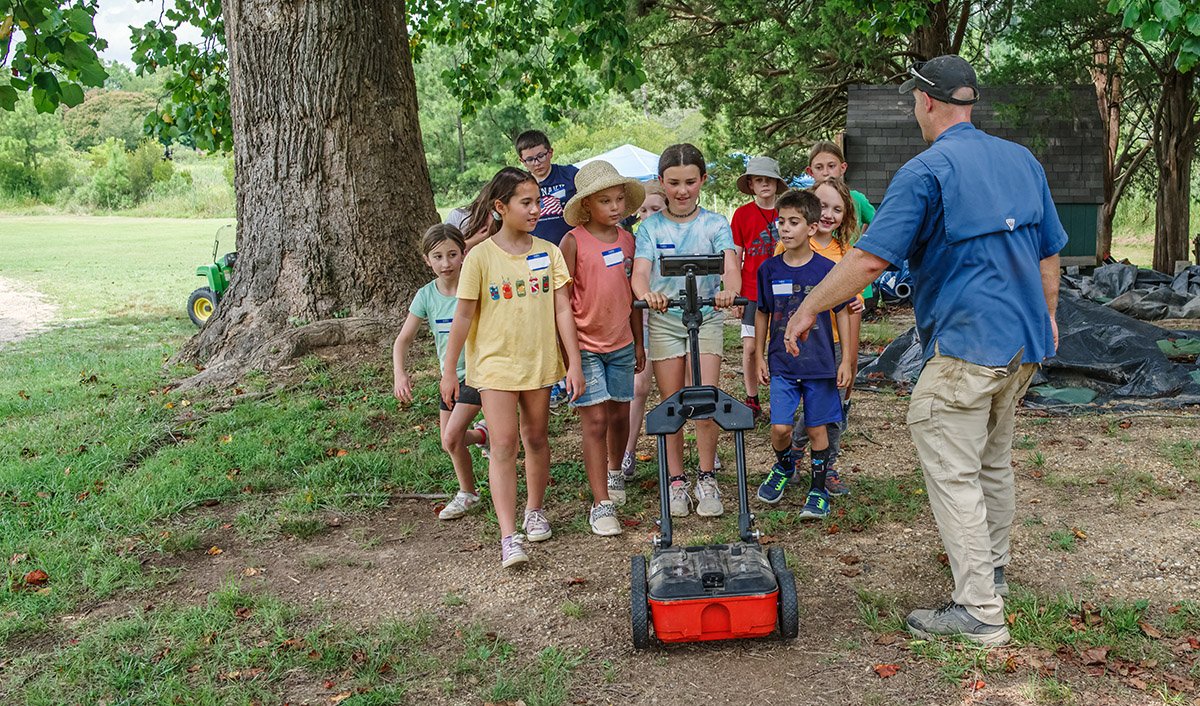
Ground-penetrating radar (GPR) is becoming an indispensable tool for archaeologists and the staff made sure to include instruction on the technology and give the campers hands-on experience using the radar devices. The campers used one such radar machine, resembling a lawn mower, to conduct a survey on part of the property to determine if features lay below the modern surface. The archaeological team is currently analyzing the new data and adding it to the map of existing data. GPR enables a “view” under the surface without the need to lift a shovel but the results can be obscured by roots, water, and modern made-made objects such as water pipes and electrical lines. It is a valuable tool in the archaeologist’s arsenal and greatly aids the Jamestown Rediscovery team in their decisions on where to start excavations and what to expect as they go down. The campers also spent time indoors with the curatorial team. After a tour of the Vault where they got to go hands-on with some of the artifacts in the collection, they engaged in a sorting exercise with artifacts found in the fort’s first well.
On the last day of Kids Camp, the campers presented their findings to their families and shared trays of artifacts that they found during their excavations of the borrow pit. Among their favorite artifacts were lead shot, Chinese porcelain, English flint, and a cut fragment of a Spanish eight real, a “piece of eight” made famous in pirate lore. This fragment matches similar coins which were minted in Mexico City, during the reign of King Carlos III or IV. This is the first eight real in the Jamestown collection and it would have been legal tender in the United States until 1857. On the coin’s obverse a portion of the king’s head and his laurel wreath is visible. On the reverse, a fragment of the crown at the top of the coin can be seen. The edge of the coin bears an alternating pattern of rectangles and circles that would have made counterfeiting more difficult. The campers also found sherds of a Westerwald salt-glazed stoneware jug, perhaps from the same vessel found by the field school students in late June. That jug commemorates Queen Mary II of England who co-reigned with her husband William III from 1689 until her death in 1694.
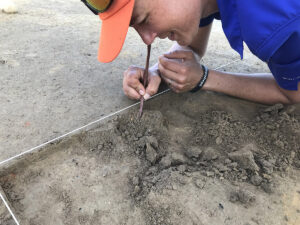
Senior Staff Archaeologist Mary Anna Richardson Hartley, with help from Senior Staff Archaeologist Sean Romo and Site Supervisor Anna Shackelford, is excavating one of the subfloor pits in the north field excavations. These features were discovered using GPR and occur at regular 18-foot intervals running east/west in this area, a few feet from the expanding Pitch and Tar Swamp to the north. The excavation of the feature is in its early stages and it’s still unclear what its purpose was. Some pig and deer bones have been found in the feature so far, as well as sherds of Virginia Indian pottery. The plan in this area is to open more squares to the east and perhaps to the north, investigating additional possible features suggested by GPR surveys.
The team was excited to work with the archaeological firm SEARCH in late June. Search does both terrestrial and underwater archaeology and came highly recommended as a partner for investigating submerged resources both in and around Jamestown Island. As the Pitch and Tar Swamp continues to rise, spread, and claim more land, Jamestown Rediscovery is committed to investigating ways to save the archaeological resources that are under threat, including those that are already underwater. The collaborative project and its results are under wraps for the moment but stay tuned for updates in the weeks ahead.
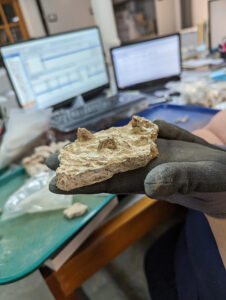
This month in the vault, curator Leah Stricker has focused her attention on copper alloy, iron, and a few silver clothing hooks and eyes. Clothing hooks and eyes were sewn into clothing, on the opposite sides that were to be fastened, and the 17th century examples are remarkably similar to hooks and eyes used today. Clothing hooks and eyes were sewn into clothing, on the opposite sides that were to be fastened. Curatorial Assistant Lauren Stephens continues her work on architectural materials for the reference collection. This month she has been focused on plaster and mortar, primarily from the 1617 Church. She is investigating differences in the plasters used on interior walls versus exterior ones. Also early plasters tend to be lighter in color than later examples. A notable plaster sample in the collection has protrusions on the back. These would fill depressions — made by the plasterer’s knuckles — in a backing coat of mud. The mud itself was adhered to the wooden walls of the Church. Assistant Curator Emma Derry worked with Dr. Ashley McKeown of Texas State University this month to complete the lab analysis on the three burials excavated last fall. Emma and Ashley focused on physical evidence of age, sex, health, activity patterns, and ancestry, as well as any anomalies. The two older colonists were male while the third died too young to be able to determine their sex from the skeleton. DNA samples were also taken last fall, but the processing and analysis is not yet complete.
Long attached to an iron hinge via corrosion, a lead seal was conserved this month bearing an image of the sun with rays emanating from it (“sun in splendour”) with a human face and the letters “W” and “I” below it in ligature form. Found in one of the pits inside the western palisade wall, corrosion caused the two objects to adhere to one another. An x-ray gave some clarity to the rusted mess and Conservator Don Warmke used air abrasion to separate the two objects. Senior Conservator Dan Gamble then used a scalpel to slowly remove corrosion from the seal itself. This is the second lead seal of this type in the Jamestown collection, though it is unknown what person the symbolism represents. William & Mary student Cathrine Davis is studying this and the other Jamestown lead seals for her PhD dissertation. Dan has also been busy this month conserving the piece of eight fragment found at the borrow pit, along with several buttons and clothing eyes. Don continues his work x-raying the iron objects in our collection. This month he has x-rayed objects ranging from stirrups to bullet molds, locks, and clothing eyes.
dig deeper
related images
- A camper and archaeologist Josh Barber at the pile of already-screened soil.
- A camper shares a sherd of Chinese porcelain that she found at the borrow pit excavations.
- A camper holds the piece of eight that he found while screening. He is showing the reverse side of the coin. Some of the crown is visible.
- The edge of the eight real “piece of eight.” Note the alternating circle/rectangle pattern.
- The obverse of the eight real. Part of the king’s (Carlos III or IV) head and laurel wreath are visible.
- Archaeological staff and campers excavating at the borrow pit site.
- Senior Staff Archaeologist Sean Romo shares the results of the kids’ GPR surveys.
- Campers screening for artifacts
- Senior Staff Archaeologist Sean Romo and campers screen for artifacts in the soil excavated from the clay borrow pit.
- Water screening elicited mixed reviews from the campers.
- Curator Leah Stricker teaches Kids Camp attendees about some of the artifacts in the collection.
- The campers share the experiences of Kids Camp with their families. Staff Archaeologist Natalie Reid leads the discussion.
- Campers share their artifact finds with family on the last day of camp.
- Field school students attending William & Mary (Janne Wagner, Lianna Styles, and Ren Willis) hold sherds of the Mary II Westerwald jug. William & Mary was named in honor of Mary and her husband King William III.
- Sherds from the Westerwald jug celebrating the reign of Mary II, Queen of England. These sherds were found by the field school students.
- The field school students (in the well ring) and archaeological staff. The well will be dug in earnest in August.
- Jamestown Rediscovery and Search archaeologists in the swamp north of the Rediscovery Center.
- A copper alloy clothing eye
- A copper alloy clothing hook
- Some of the clothing hooks and eyes in the Jamestown collection.
- A Victorian-era carnival glass button bearing an oak leaf and acorn.
- The unconserved lead seal (gray object on right side) attached to a corroded iron hinge.
- An x-ray of the lead seal and iron hinge, stuck together because of corrosion. The lead seal can be seen as white near the top left, white meaning the x-rays didn’t penetrate the dense metal.
- An example of the same lead seal type already in the collection


